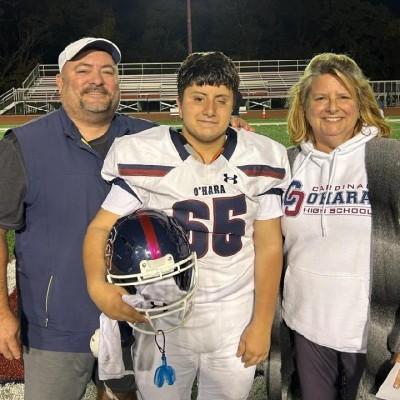You are here
Update on Cord Blood Transplant Survivor Mason Shaffer
Mason Shaffer received a cord blood transplant in 2009 at age 7 months for the rare condition Malignant Infantile Osteopetrosis (MIOP). He is now living his best life as a rising high school sophomore in Drexel Hill, Pennsylvania, USA.
Osteopetrosis is not a blood disease; it is a genetic disorder that causes excessive bone growth1. This runaway growth of the bones causes them to put pressure on various nerves and organs, it reduces the space left inside the bones for bone marrow, and the MIOP form of osteopetrosis leads to death at a very young age. But Mason is alive today because some unknown mother donated her child’s cord blood and he had a life saving transplant when he was still an infant.
 We profiled Mason’s family in Sept. 2013, and now we are catching up with them again nearly eleven years later2. Thanks to the cord blood transplant, the progression of Mason’s osteopetrosis was stopped in its tracks and his metabolism returned to normal. He has been able to grow up doing the same things as other children. Mason does have some residual health problems from the damage that the osteopetrosis caused before the transplant. The excess bone growth was crushing some of the nerves in his head, and to this day Mason lacks feeling in some of his facial nerves, he is blind in his left eye, and he has very poor vision in his right eye.
We profiled Mason’s family in Sept. 2013, and now we are catching up with them again nearly eleven years later2. Thanks to the cord blood transplant, the progression of Mason’s osteopetrosis was stopped in its tracks and his metabolism returned to normal. He has been able to grow up doing the same things as other children. Mason does have some residual health problems from the damage that the osteopetrosis caused before the transplant. The excess bone growth was crushing some of the nerves in his head, and to this day Mason lacks feeling in some of his facial nerves, he is blind in his left eye, and he has very poor vision in his right eye.
Despite his vision deficit, Mason can read text with large print. He has always been in mainstream classes at school and has good grades. He is currently taking all honors classes at his high school and expects to take some advanced placement college classes before he graduates. Mason also enjoys music and plays both the drums and the piano.
What is most remarkable for a boy who once had abnormal bones, is that Mason has been very active in sports. His older brother Reilly is a competitive swimmer, and Mason followed his path into the pool and spent ten years in swimming leagues. In middle school Mason took up the martial art Brazilian Jiu Jitsu, and in his freshman year of high school he played on the football team. This is American-style football, where heavily padded players charge at each other, and defensive players do not have to be able to see the ball from far away.
Mason’s mother, Sarah Shaffer, started the Mason Shaffer Foundation in 20112. This became a family project that included her husband Marc and their children. One goal of the foundation was to form a community for parents of children with osteopetrosis, to provide them with a support network. The Mason Shaffer Foundation also ran a cord blood donation program at two hospitals in the Philadelphia area, but after several years this program was closed because it was not cost-effective for their local public bank to accept donations from those hospitals.
Since Mason’s transplant in 2009, success rates for stem cell transplants of children with infantile osteopetrosis have improved, and there is a growing community of survivors3,4. Mason has continued to be a pioneer in this arena, and became the first osteopetrosis patient to go through oral surgery to expand his palate and widen his airway.
After ten years, Sarah Shaffer has stepped away from running the Mason Shaffer Foundation, and hopes that some of the younger parents will assume leadership of the community. Sarah found that, while she needed the foundation as an outlet to talk to other osteopetrosis parents, Mason was not interested in the foundation because he just wanted to lead a normal life. Although it was upsetting to let go of running the foundation, Sarah realized that it was time to embrace the fact that Mason had recovered and to move on. Mason plans to attend college after high school, but beyond that he has not picked a career path. After everything they have been through, the Shaffer family holds the philosophy that life is uncertain, and you can’t overly plan what you expect to happen, just be prepared to roll with things as they come.
References:
- National Institute of Arthritis and Musculoskeletal and Skin Diseases. Osteopetrosis. Last reviewed 2023-08
- Shaffer S. Mason Shaffer Foundation. Parent's Guide to Cord Blood Foundation Newsletter Published 2013-09
- Orchard PJ, Fasth AL, Le Rademacher J, He W, Boelens JJ, ... Eapen M. Hematopoietic stem cell transplantation for infantile osteopetrosis. Blood 2015; 126(2):270–276.
- Shapiro G, Fishleder J, Stepensky P, Simanovsky N, Goldman V, Lamdan R. Skeletal Changes After Hematopoietic Stem Cell Transplantation in Osteopetrosis. Journal of Bone and Mineral Research. 2020; 35(9):1645–1651.
